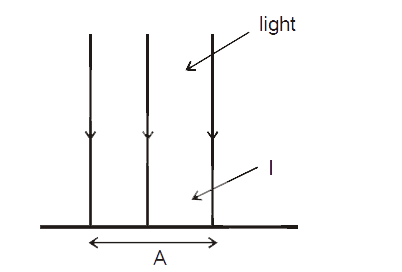Two separate monochromatic light beams A and B of the same intensity (energy per unit area per unit time) are falling normally on a unit area of a metallic surface. Their wavelength are λA and λB respectively. Assuming that all the the incident light is used in ejecting the photoelectrons, the ratio of the number of photoelectrons from beam A to that from B is
λBλA
λAλB
Both (1) & (2)
None of these
The correct Answer is:B
Step by step video, text & image solution for Two separate monochromatic light beams A and B of the same intensity (energy per unit area per unit time) are falling normally on a unit area of a metallic surface. Their wavelength are lambda_(A) and lambda_(B) respectively. Assuming that all the the incident light is used in ejecting the photoelectrons, the ratio of the number of photoelectrons from beam A to that from B is by Physics experts to help you in doubts & scoring excellent marks in Class 12 exams.
Updated on:21/07/2023Topper's Solved these Questions
- DUAL NATURE OF RADIATION AND MATTERBOOK - NARAYNACHAPTER - DUAL NATURE OF RADIATION AND MATTEREXERCISE - EVALUTATE YOURSELF - 3
5 Videos
- DUAL NATURE OF RADIATION AND MATTERBOOK - NARAYNACHAPTER - DUAL NATURE OF RADIATION AND MATTEREXERCISE - EVALUTATE YOURSELF - 4
5 Videos
- DUAL NATURE OF RADIATION AND MATTERBOOK - NARAYNACHAPTER - DUAL NATURE OF RADIATION AND MATTEREXERCISE - EVALUTATE YOURSELF - 1
2 Videos
- CURRENT ELECTRICITYBOOK - NARAYNACHAPTER - CURRENT ELECTRICITYEXERCISE - Level 6
43 Videos
- DUAL NATUREBOOK - NARAYNACHAPTER - DUAL NATUREEXERCISE - LEVEL-II (H.W)
17 Videos
Similar Questions
Two monochromatic light beams of intensity 16 and 9 units are interfering.The ratio of intensities of bright and dark parts of the resultant pattern is: (a) 16/9 (b) 4/3 (c) 7/1 O (d) 49/1
View SolutionA beam of light has three wavelengths 4144Å, and 6216Å with a total instensity of 3.6×10−3Wm−2 equally distributed amongst the three wavelengths. The beam falls normally on an area 1.0cm2 of a clean metallic surface of work function 2.3 eV. Assume that there is no loss of light by reflection number of photoelectrons liberated in two seconds.
View Solution
Knowledge Check
If E is an electric field and B is the magnetic induction then the energy flow per unit area per unit time in an electromagnetic field is given by
AE×BBE-BCE2+B2DE/BA beam of light has two wavelengths 4,972Åand6,216Å with a total intensity of 3.6×10−3Wm−2 equally distributed among the two wavelengths . The beam falls normally on an area of 1cm2 of clean metallic surface of work function 2.3 eV . Assume that there is no loss of light by reflection and that each capable photon ejects one electron. The number of photoelectrons liberated in 2 s is approximately
A6×1011B9×1011C11×1011D15×1011If K1andK2 are maximum kinetic energies of photoelectrons emitted when light of wavelength λ2andλ1 respectively are incident on a metallic surface. Ifλ1=3λ2 then
AK1>(K23)BK1<(K23)CK1=3K2DK2=3K1
A beam of light having wavelength λ and intensity 1 falls normally on an area A of a clean surface then
find out the number of photon incident on the surface.

View SolutionTwo beams one of red light and other of blue light of the same intensity are incident on a metallic surface to emit photoelectrons. Which one of the two beam emits electrons of greater kinetic energy?
View SolutionUltraviolet light of wavelength 300nn and intensity 1.0Wm−2 falls on the surface of a photosensitive material. If one per cent of the incident photons produce photoelectrons, then the number of photoelectrons emitted per second from an area of 1.0 cm2 of the surface is nearly
View SolutionPhotoelectric emission is observed from a metallic surface for frequencies v1andv2 of the incident light. If the maximum value of kinetic energies of the photoelectrons emitted in the two cases are in the ratio n:1 then the threshold frequency of the metallic surface is
View SolutionIf K1andK2 are maximum kinetic energies of photoelectrons emitted when light of wavelength λ1andλ2 respectively are incident on a metallic surface. If λ1=3λ2 then
View Solution
